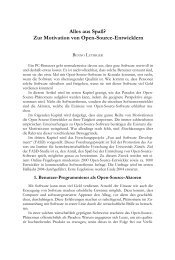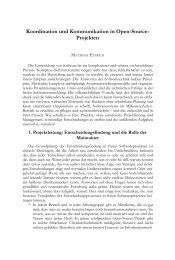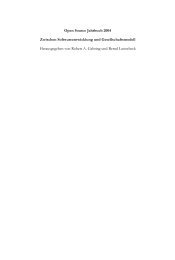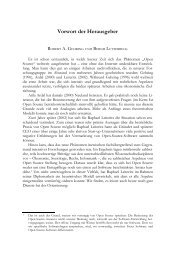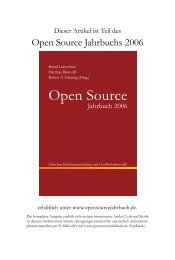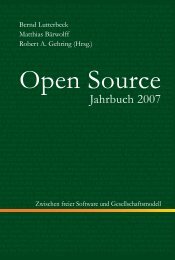Open Source Jahrbuch 2005
Open Source Jahrbuch 2005
Open Source Jahrbuch 2005
Sie wollen auch ein ePaper? Erhöhen Sie die Reichweite Ihrer Titel.
YUMPU macht aus Druck-PDFs automatisch weboptimierte ePaper, die Google liebt.
���� ������ �� ��������������� �� ���� ������<br />
strong intellectual property rights. Since the core of commons-based<br />
peer production entails provisioning without direct appropriation and<br />
since indirect appropriation intrinsic or extrinsic does not rely on<br />
control of the information but on its widest possible availability, intellectual<br />
property offers no gain, only loss, to peer production. While<br />
it is true that free software currently uses copyright-based licensing to<br />
prevent certain kinds of defection from peer production processes, that<br />
strategy is needed only as a form of institutional jujitsu to defend from<br />
intellectual property. A complete absence of property in the software<br />
domain would be at least as congenial to free software development as<br />
the condition where property exists, but copyright permits free software<br />
projects to use licensing to defend themselves from defection. The same<br />
protection from defection might be provided by other means as well,<br />
such as creating simple public mechanisms for contributing one's work<br />
in a way that makes it unsusceptible to downstream appropriation a<br />
conservancy of sorts. Regulators concerned with fostering innovation<br />
may better direct their efforts toward providing the institutional tools<br />
that would help thousands of people to collaborate without appropriating<br />
their joint product, making the information they produce freely<br />
available rather than spending their efforts to increase the scope and<br />
sophistication of the mechanisms for private appropriation of this public<br />
good as they now do. (Benkler 2002)<br />
Benkler's prescriptions seem like predictions. In recent years the governments of<br />
nation-states as diverse as South Africa, Brazil, and the Peoples' Republic of China have<br />
adopted policies that would encourage the dissemination of <strong>Open</strong> <strong>Source</strong> Software.<br />
More signi cantly, the <strong>Open</strong> <strong>Source</strong> model has moved far beyond software. Musician<br />
and composer Gilberto Gil, the culture minister of Brazil, has released several<br />
albums under a �������� ������� license. Such licenses (under which this paper lies<br />
as well) are based on the ��� ������� ������ �������, which locks the content<br />
open. It requires all users of the copyrighted material to conform to terms that<br />
encourage sharing and building (Dibell 2004).<br />
Other signi cant extra-software projects based on the <strong>Open</strong> <strong>Source</strong> model include<br />
���������, a remarkable compilation of fact and analysis written and reviewed by<br />
a committed team of peers placed around the world. The scienti c spheres have<br />
rediscovered their commitment to openness through the movement to establish and<br />
maintain <strong>Open</strong> Access Journals, thus evading the proprietary traps (and expenses) of<br />
large commercial journal publishers (Kaiser 2004). By 2004, citizen-based journalism,<br />
often known as <strong>Open</strong> <strong>Source</strong> Journalism grew in importance and established itself as<br />
essential element of the global information ecosystem (see Rosen 2004, Gillmor<br />
2004). Such experiments are sure to proliferate in response to the failures (market<br />
and otherwise) of proprietary media forms (Kelty 2004).<br />
363



